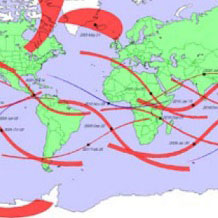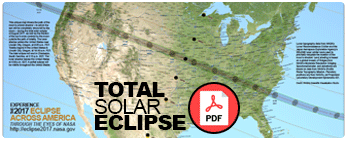NASA Wavelength
NASA Wavelength is your pathway into a digital collection of Earth and space science resources for educators of all levels – from elementary to college, to out-of-school programs, and informal education events. These resources, developed through funding of the NASA Science Mission Directorate (SMD), have undergone a peer-review process through which educators and scientists ensure the content is accurate and useful in an educational setting. Use NASA Wavelength to quickly and easily locate resources, and even share the resources you discover with others through social media and e-mail. You can also use NASA Wavelength to quickly locate additional resources, create your own personalized lists of activities, and connect to national education standards. http://nasawavelength.org/
The following are only a some of the many resources for an eclipse that you will find on NASA Wavelength.
Eclipse: An IntroductionThis is an activity introducing the topic of eclipses with a focus on solar eclipses. Learners will first identify what they already know about eclipses. They will also vocalize any questions they may have concerning eclipses. Next, a book is read out loud in class and students are asked to identify related vocabulary words for a Science Reading Wall as well as determine if any answers have been found for their initial questions. Lastly, learners will complete journal prompts to better identify concepts learned. This activity will require the acquisition of one of two listed books. This is Activity 10 of a larger resource, entitled Eye on the Sky. http://www.eyeonthesky.org/lessonplans/10sun_eclipse.html
Making a Solar Eclipse Book: The Sun and Moon During Solar EclipseThis is an activity about how to model and label a solar eclipse. Learners will paint and label an illustration of the Sun and Moon as they appear during a solar eclipse. Learners will also use their illustrations of the Sun to write a descriptive paragraph of solar characteristics and features. These illustrations are meant to be used as covers for their portfolio book which will contain the work sheets and student writings compiled throughout the entire Eye on the Sky suite of lessons. This is Activity 13 of a larger resource entitled Eye on the Sky. http://www.eyeonthesky.org/lessonplans/13sun_eclipsebook.html
Teaching Planetary Sciences - Eclipses
This is the third in a series of three professional development videos that correspond to lessons taught by Andrew Cloud, an Earth and planetary sciences teacher, with a class of 9th and 10th grade students. In this lesson, Andrew introduces the concept of eclipses. He asks for student volunteers to represent the Sun (holding a flashlight), the Earth, and the Moon. He then asks the class to think about the order in which the volunteers should be assembled to create the conditions for a lunar eclipse to occur. The demonstration was reinforced by the use of the "Lunar Eclipse Essentials" video. In a final activity, students drew diagrams to illustrate a Lunar Eclipse and a Solar Eclipse. Includes teaching tips and discussion questions. http://www.pbslearningmedia.org/resource/npls12.pd.sci.eclipse/teaching-planetary-science-phases-of-the-moon/
Measuring Angular Size and Distance
This is an activity about measuring angular size and understanding the solar and lunar proportions that result in solar eclipses. Learners will use triangles and proportions to create a shoebox eclipse simulator. They will then apply what they learn about angular size to predict the diameter and distance of one object that can be eclipsed by another. They will also complete three journal assignments to record observations and conceptual understanding. This activity derives from those demonstrated in the NASA CONNECT television series episode, titled Path of Totality. http://wayback.archive-it.org/5717/20140812004255/http:/www.knowitall.org/nasa/pdf/connect/Path_of_Totality.pdf








